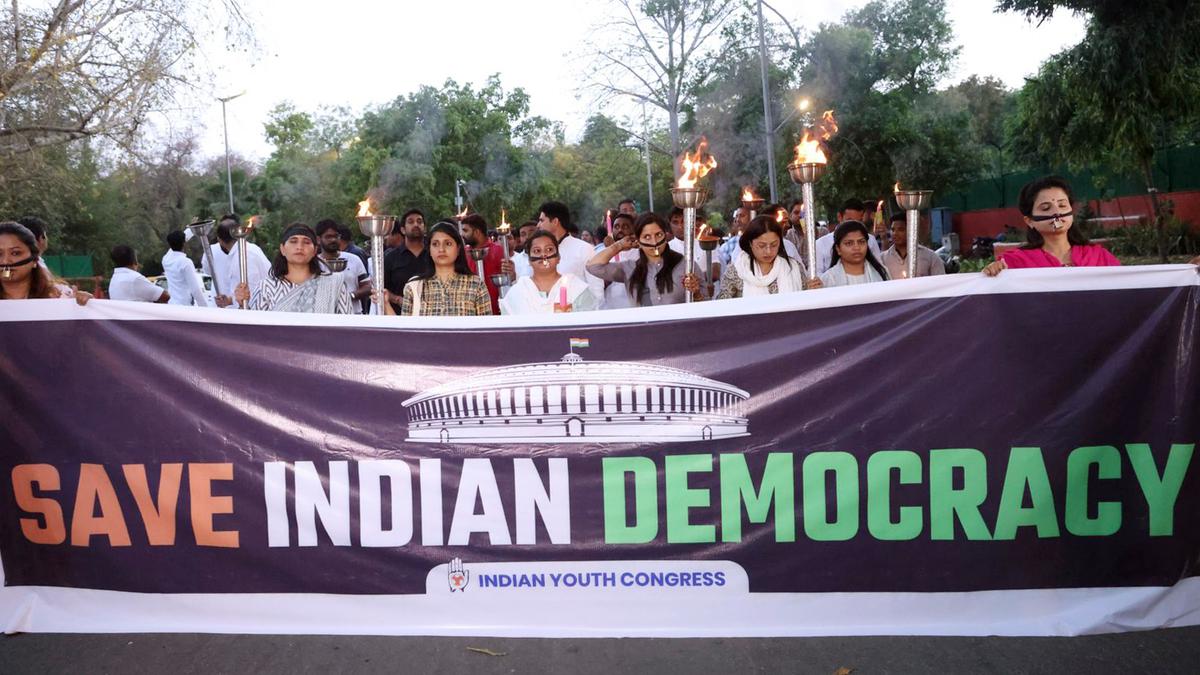Death of Free Speech in India's Press | Fact or Paranoia? | Akash Banerjee & Dharmesh https://www.youtube.com/watch?v=wCPg_6vpv3g
Prashant Kishor का राहुल गाँधी के लिए सॉफ्ट कार्नर, इंटरव्यू में कांग्रेस नेता के पक्ष में ये कहा https://www.youtube.com/watch?v=E51AGa5XCFI
Supreme Court Asks Centre To File Response In Plea To Protect Western Ghats https://www.livelaw.in/top-stories/supreme-court-protection-of-western-ghat-deforestation-destruction-conservation-writ-petition-224560 Aiman J.Chishti 23 Mar 2023
“The protection of the Western Ghats has a direct impact on the right to life and livelihood protected under Article 21 of the Constitution. Furthermore, as the Western Ghats is a continuous living chain of mountains which passes through six states, it requires the involvement of all six state governments, and relevant regulatory agencies in these states, along with Central Government ministries,”states the petitioner.
The Central Government has accepted the HLWG's report but has only issued Section directions under Section 5 of Environment Protection Act,1986(EPA) regulating activities in 56,825 sq. km. (reduced from 59,940 sq. km.) by an amendment dated 03.12.2018 after Kerala's recommendation without examination by MoEFCC. 72,212 sq. km. identified by WGEEP as the Western Ghats have been excluded from legal protection.
Illegal homestays turn into bane for Karnataka Ghats https://www.deccanherald.com/state/uttara-kannada-belagavi-city/illegal-homestays-turn-into-bane-for-karnataka-ghats-1203858.html Illegal resorts and homestays in Uttara Kannada are posing a threat to the ecologically sensitive Western Ghats besides causing losses to the state exchequer Pavan Kumar H, DHNS, Hubballi, MAR 27 2023
Tourism Department Minister Anand Singh in the Legislative Council during the February session. According to his reply to an unstarred question by MLC N Ravikumar, there are only eight resorts “registered” with the department, including the Old Magazine House, Kali, and Anshi nature camps that are operated by the government. The reply says the department “does not have any information of unauthorised resorts in the region and does not have powers to act against such properties”.
As per the office of Deputy Director of Tourism (DDOT), Karwar, there are more than 200 homestays and 14 resorts functioning in the picturesque taluks of Joida, Dandeli and Haliyal.
 Mumbai PM 2.5 was twice the limit on half of January-February days https://timesofindia.indiatimes.com/city/mumbai/mumbai-pm-2-5-was-twice-the-limit-on-half-of-january-february-days/articleshow/99101737.cms
Mumbai PM 2.5 was twice the limit on half of January-February days https://timesofindia.indiatimes.com/city/mumbai/mumbai-pm-2-5-was-twice-the-limit-on-half-of-january-february-days/articleshow/99101737.cms
TNN / Mar 30, 2023
The city recorded 27 "poor air" days, when daily average PM2.5 levels were between 90 and 120 ug/m3, in January and February, compared with just six such days in the corresponding period last year, reports Chittaranjan
But some places were significantly worse than others. PM 2.5 levels almost or more than doubled in BKC, Deonar, Bhandup (Khindipada) and Sion in February compared to last year.
Suburban air quality has shown a steep decline. BKC saw 15 'very poor' and two 'severe' air days, while Deonar saw 26 'very poor' air days this February. Colaba, CSIA, Mulund, Powai, Worli and Kandivli-E also saw increases in PM2.5 levels, though less sharp, in the same period.Tembhekar./99101737.cms?utm_source=contentofinterest&utm_medium=text&utm_campaign=cppst
'Criticism Of Govt Not Anti-India' : Lawyers Condemn Law Minister Kiren Rijiju's Comment Against Retired Judges LIVELAW NEWS NETWORK 29 Mar 2023 https://www.livelaw.in/top-stories/lawyers-response-union-law-minister-kiren-rijiju-speech-attack-on-judiciary-retired-judges-anti-india-gang-225070 Over 300 lawyers from the Supreme Court and various High Courts have issued a statement condemning the comment of Union Law Minister Kiren Rijiju that "some retired judges belong to anti-India gang". Taking strong objection to the Minister's comment, the lawyers said : "We may remind the Minister the lawyers said : "We may remind the Minister that criticism of the government is neither against the nation, nor unpatriotic, nor “anti-India”.
Whats app Extract by MD :
Observations of the Ld. Sessions Court, Mehsana while acquitting 10 accused including MLA Jignesh Mevani, Subodh Parmar, Reshma Patel and Kaushik Parmar.
Para 30.
" This court is of the view that right of freedom enshrined in the constitution is not only for academic purpose but in fact it is the founding stone of democractic nation. In the democratic set up, deliberations, discussions, debates and bonifide dissent against policies of government and even bonafide criticism of in action of government are essential for existence of democracy in nation.
It would be worth to note that nowadays misuse of power of statutory authority and misuse of process of law for suppressing voice of people and showing dominance of power is not unknown even in democratic set up. Therefore this court reminds that it is the pious duty of ruler of every democratic nation to protect right of freedoms of citizens without any fear of criticism for survival of ethos of democracy in the nation because in democratic set up elected leaders are not meant to rule over the people but in fact they are meant to serve the people of nation. Moreover, this court is also of the view that if in democratic set up every dissent and peaceful protest is branded as offence then right of freedom no place in democratic set up.
Para 31 - hence in view of aforesaid factual background of case this court is of the view that entire case of prosecution is baseless and without any substance or evidence. In the result accused are required to acquitted from offence and thus imunged judgement of conviction passed by learned trial court deserves to be set aside "
अमित शाह की पुलिस ने 5400 बार फर्जी 144 धारा लगाईं, Misuse of Section 144, imposed 6K times in Delhi https://www.youtube.com/watch?v=g4qzG5uuAkA
Section 144 imposed 6K times in Delhi in 2021-22 for mostly mundane tasks like installing CCTVs: Study https://www.indiatoday.in/law/story/section-144-imposed-6000-times-in-delhi-in-2021-22-for-mostly-mundane-tasks-like-installing-cctvs-study-2352039-2023-03-27 A new report, ‘The Use & Misuse of Section 144 CrPC’, has found that 6,100 prohibitory orders were issued in the national capital in 2021-2022. The report launched in the presence of the former Chief Justice of India (CJI) UU Lalit and senior advocate Rebecca John has been compiled by four lawyers, including Vrinda Bhandari, Abhinav Sekhri, Natasha Maheshwari, and Madhav Aggarwal. The report has studied 5,400 out of the 6,100 orders issued, as the remaining 700 orders were not provided to lawyers citing ‘national interest’. The report categorises the orders into four segments: establishing CCTV surveillance, regulating business (through compulsory record and register of documents), securing public order (whether through preventing/regulating unlawful assembly or regulation of kite flying, firecrackers, or hookah bars), and outliers. The report found that the maximum number of orders were passed for installing CCTV cameras, which constitute more than 25% of the total. The highest number of orders were issued to install CCTVs inside and outside NBFCs, courier operators, girls' schools, and paying guests.
“State surveillance is being supplemented by a vast parallel network of private actors being asked to install CCTVs — ATMs, banks, NBFCs and other financial institutions, liquors vends, courier services, girls’ schools and PGs, hotels, amusement parks and cinema halls,” it noted.
“In effect, we have with us a setup where Big Brother is always watching, whether we are watching a movie with a friend or sending a package to a loved one,” states the report, which includes Vrinda Bhandari and Madhav Aggrawal as authors.
‘Time to challenge it’
‘Conferring drastic powers upon the executive through Section 144 unacceptable’ https://www.thehindu.com/news/cities/Delhi/conferring-drastic-powers-upon-the-executive-through-section-144-unacceptable/article66664919.ece
Senior advocate Rebecca Mammen John said the time has come to challenge the constitutional validity of the prohibitory orders. “Section 144 is an emergency provision to prevent rioting, and maintain tranquillity and peace. But as per this report, the State uses it to snoop on regular life,” she said at the event. Ms. John noted she was unaware of this CrPC Section being used as “creatively” as had been highlighted in the report.“Time has come for us to revisit it in the court. Because this is not a power with any judicial oversight and scrutiny. This is a completely executive power,” she said.
Five reasons why Modi-Shah allowed Rahul Gandhi to become a 'martyr' https://youtu.be/8AiZDoqYyFE?t=288 ThePrint
Mar 29, 2023 Rahul Gandhi's 'victimisation' has fired up the opposition but here are five reasons why Modi-Shah must be happy about it, ThePrint Political Editor DK Singh explains in this episode of #PoliticallyCorrect
Karnataka elections - Caste arithmetic in Karnataka, shifting focus to central issues
Trying to victim RG vs Autocratic centre. belief in Modi centric campaign
Modi v/s Rahul to relegate main issues
purported insult of OBC
Congress seems emboldened by support of opposition. BJp believes that this is misplaced..
A disturbing example of the normalisation of lawfare https://www.thehindu.com/opinion/lead/a-disturbing-example-of-the-normalisation-of-lawfare/article66672779.ece March 29, 2023

The case of the former Wayanad MP also spotlights the danger courts could face to their legitimacy — namely, losing their reputation for impartiality between contending political forces.... the conviction and disqualification of Mr. Gandhi represents another signpost in a concerning drift towards the normalisation of lawfare as a political tactic. It is concerning because one crucial component of the legitimacy of courts is their reputation for impartiality between contending political forces. Recent examples from Poland and Hungary have shown how quickly that reputation can be lost. It is for the judiciary to ensure that what could also happen here, does not happen here.
- Twitter & State
- On Doctored video of youth congress chief remark
- Rahul Gandhi को क्यों मिली सजा और बेल राहुल के वकील B M Mangukiy ने बताया
- Union Govt 'Has No Data' on Indians' Offshore Shell Companies
- Human rights body directs state govt, BMC to improve living conditions in M/East ward
- History of RSS - Dr Ram Puniyani
- Bhagat Singh: Relevance today
- Why Far Right Extremism Needs to Be Designated as Terrorism
- The Rise of the BJP
- Rahul Gandhi's Speech in London
- Fighting Bad PRess
- explosions for opencast mining. Agricultural labourers and farmers evicted
- There can be no Bhagat Singh without his ideology
- A Yawning Gap Between the Myth and the Reality of Modi 2.0
- PMLA
- Time Line of Choksi Case: Surjewala
- Uncertain Justice: The Citizens Committee Report on North East Delhi Violence 2022
- किरण पटेल ने उगल दिया मोदी सरकार का पूरा सच
- Primer on wealth inequality
- As BJP tries to suspend Rahul Gandhi over his democracy remarks, here's a look at the rules of suspension of MPs
